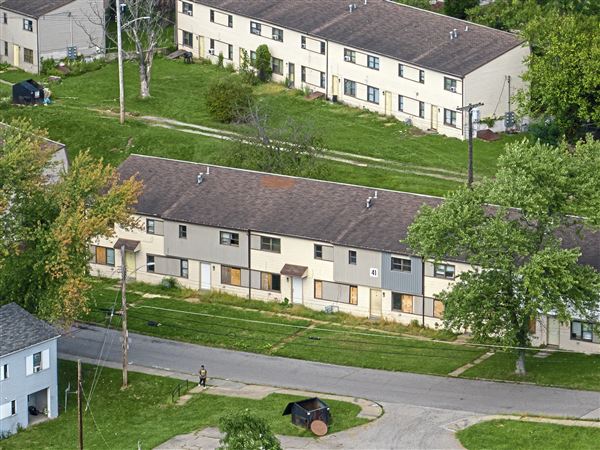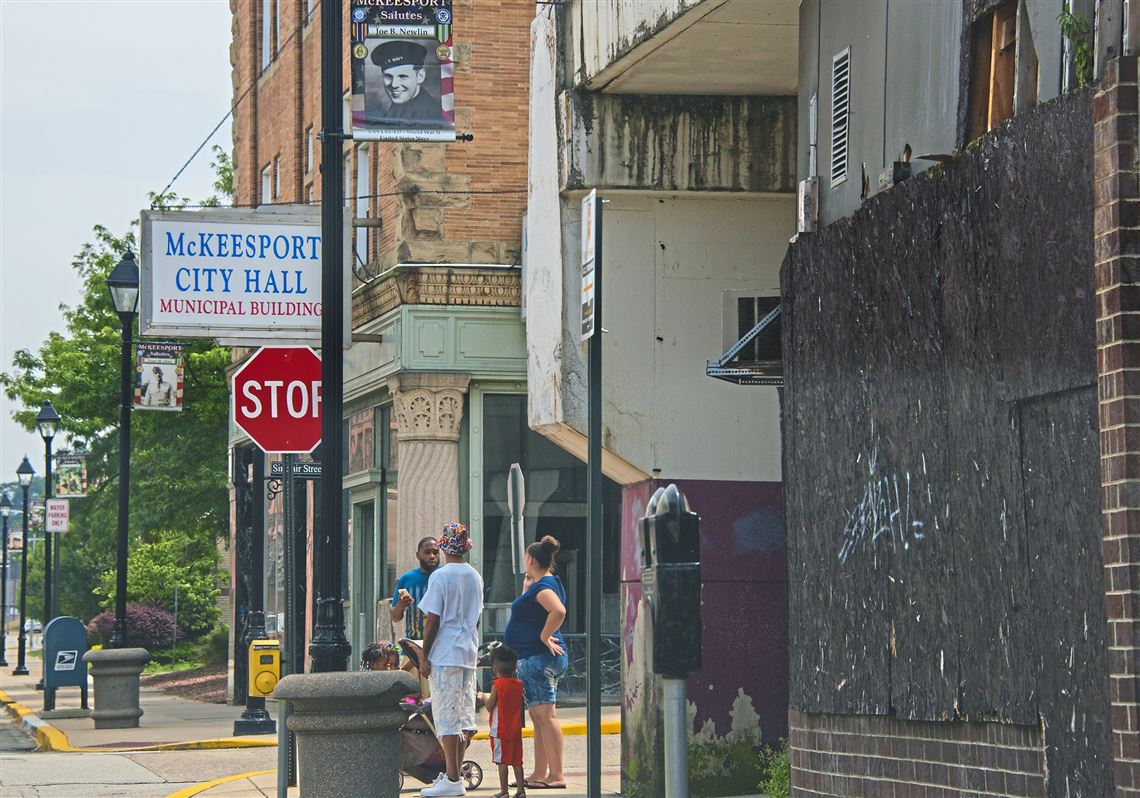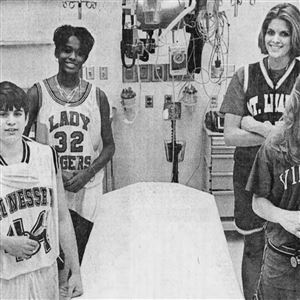Only 12 highway miles separate McKeesport and Upper St. Clair and even closer for the crow. But that proximity belies the fact they are different worlds — nearly socioeconomic opposites in southwestern Pennsylvania.
People living in Upper St. Clair, whose average household income is $113,000, talk openly about the benefits of living in the township. Many homes are majestic structures in tree-lined neighborhoods, with low crime rates and a quality school district.
In McKeesport, people talk more about leaving. Some neighborhoods feature packed-together substandard houses interspersed with vacant ones sinking into the weeds and full of broken windows. Strangers are advised against driving these streets, even in daylight.
The city’s average household income of $25,700 and per-capita income of $17,800 flirt with the poverty line. Residents discuss their struggles — feeding the family, silently contending with health problems, struggling to find and hold a job to keep the lights on and water running.
Those differences have a significant impact on their respective residents, showing how a person’s address dramatically affects health and well-being: the median age of death in Upper St. Clair is 85.9 years. In McKeesport, it’s 76.5. That’s a difference of 9.4 years.
Mark Leptinsky, 52, an Elizabeth Township native who graduated from Serra Catholic High School in McKeesport, is an electrical engineer for General Electric. He moved to Upper St. Clair 22 years ago with his wife Kathi, due in large part to the school district — a feature others, as well, describe as a lure.
“I’m very happy with the decision of 1995,” he said. “I’m happy with the Upper St. Clair School District but there’s also a lower crime rate, very little if any violent crime. It’s something not to worry about.”
There’s a lot to worry about in McKeesport.
Raised by her grandmother, Kimberly Swain, 40, now with the Center for Victims Foundation, tells how she, as a single mom of four, couldn’t afford her electric bill at one point and lit candles throughout the house to give her neighbors the impression she still had electricity. She lost one promising job when her appendix burst. She’s struggled time and again, with low or no income, to get a degree beyond high school.
She knows the potholes and pitfalls in McKeesport.
“A lot of people don’t even know what resources are available,” she said. “Even police don’t know how to help. Who else can you turn to?”
Uncomfortable comparisons
Although Upper St. Clair and McKeesport have roughly the same size populations, placing them side by side, with their notable differences, might seem woefully unfair for both municipalities.
But they represent important bookends in the American story, pitting progress and opportunity against unemployment, poverty and despair, with the outcome being quality of life and longevity.
Divergent median age of death statistics countywide, 2011 through 2015, stood out boldly when the Allegheny County Health Department posted a county map in recent months showing lifespan by municipality.
The high end with Upper St. Clair includes Aleppo (88.3 years), Sewickley Heights (85.2), Mt. Lebanon (86), and McCandless (85.3), all having generally higher incomes and education levels, with upscale housing and access to health care, among other factors.
Municipalities with the notably lowest median age of death include Mount Oliver (67.8 years), McKees Rocks (70.2), Rankin (71.5 years), Pitcairn (72.1) and Wilkinsburg (72.2) with some of Pittsburgh’s larger neighborhoods having median lifespans in the mid-60s, and even lower for African Americans. The municipalities’ range spans more than two decades, a time period ranging from the end of Bill Clinton’s first term in office to the beginning of Donald Trump’s.
After the health department posted its map, the Post-Gazette sought two comparably sized communities to help explain lifespan variance. McKeesport has a current estimated population of 19,200 and continues shrinking, while Upper St. Clair is now at 19,800 and growing. They have flip-flopped their 2010 totals and likely had identical populations at some point in recent years.
Consider two fictional people, each born in early 1931 and living the median age of death. The McKeesport resident would have passed away before the election of Barack Obama. The Upper St. Clair resident would have seen President Trump take office.
Science exactly predicts this difference, given the health and lifestyle advantages in upscale communities and the numerous obstacles to health and well-being in impoverished communities.
These impacts start well before birth, with the mother’s lifestyle and prenatal care, or lack thereof. Other impacts are parental income, nutrition, the quality of one’s home and neighborhood, crime rates, education levels, job opportunities, race, and chronic stress levels, among many others.
“The seeds of later, adult-life diseases are really planted in childhood so that kids are subjected to conflict in stressful environments,” said Nancy E. Adler, director of the University of California San Francisco’s Center for Health and Community. “Kids starting in kindergarten have different trajectories. They are not learning as much. They are less likely to get good jobs. So they will not have good income and health benefits.”
And, unfortunately, they face a higher risk of dying younger.
Steep climb
A 2007 report, led by Ms. Adler and involving Karen A. Matthews of the University of Pittsburgh and Sheldon Cohen of Carnegie Mellon University, found that health improves at each rung of the socioeconomic ladder, with those at the top living “prosperous, healthy and secure lives” and those with insufficient income experiencing “poor health and vulnerability.”
“On the bottom rungs are people who are poorly educated, experience long bouts of unemployment or low-wage jobs, have nothing to fall back on in the way of savings, and live in substandard homes,” the report concludes.
People wrongly think that lifespan depends mostly on genetic heritage, it says.
“But it turns out that the more advantaged our lives are, the longer we live and healthier we are from birth to old age,” it states.
And it’s getting harder to move up.
Median age of death in Allegheny County municipalities, 2011-15
Harvard University’s “Equality of Opportunity Project” found that only a small percentage of people can now climb the socioeconomic ladder in the United States. Those in the bottom 20 percent of income in southwestern Pennsylvania, for example, have a mere 10 percent chance of reaching the top 20 percent. In the deep South, only 5 percent of those at the bottom will reach the top rung.
Downtown downturn
On a recent afternoon, young men and women regularly made grand entrances into Kool Kutz — the apparent place to be in McKeesport. Guys would slap then shake hands with Laneal Phifer and other barbers at the Fifth Avenue shop, before getting a haircut or just tuning into the barbershop vibe.
These festive interactions, ringing with personality, energy, humor and lots of razzing, occurred as people received skillful shaves, haircuts and braids. It was almost a ritual and routine designed to raise spirits during these troubled times.
Mr. Phifer, 40, a McKeesport native who holds a cosmetology degree, put down his clippers to discuss his hometown, where, he said, “Everyone knows everyone.” That human network is the city’s best attribute, he said, calling the barbershop, owned by Corry Sanders, “the heart and soul of the city.”
“A lot of people walk through here to see what’s happening,” he said. “We get breaking news first about anything happening in the city.” Unfortunately, much of the news and talk since April has been four street homicides, including the shooting death of a 14-year-old.
From 2010 through 2015, there were 34 murders in McKeesport.
Outside the barbershop doors, history has taken its toll on the city. Jobs are few. Resources are scant. U.S. Steel’s Duquesne plant and National Tube Works, which have closed, provided jobs and financial energy to the city. The city now has lost two-thirds of its peak 1940 population of 55,000, leaving residents to work low-paying jobs to survive, often at a subsistence level.
“I was raised here,” said Mr. Phifer, who graduated from McKeesport High School and lived in two-parent household with his father serving as an assistant chief of police during a 30-year police career. He acknowledges he’s one of the lucky few.
Hope recently arose with PurePenn LLC’s announcement that it will build a medical marijuana production and distribution center in McKeesport, attracting an estimated 1,000 job applications for the 20 to 40 available positions.
The city does have some streets lined with handsome homes, with flower beds and white fences. Its school district now has the new Twin Rivers Elementary/Intermediate School whose unique architecture has garnered national attention. It also spends nearly the same amount of money per student as does Upper St. Clair, with a student-to-teacher ratio of 13 to 1, compared with 10 to 1 in Upper St. Clair.
Still, Mr. Phifer says, he’s regretting his decision to stay in his hometown, where 34 percent of residents now live in poverty with the average housing price of $47,100 — nearly a sixth of Upper St. Clair’s. Some residents can’t afford to stay — or leave.
“I’ll be square with you,” he said. “This is not about skin color. People in control of resources don’t want to let those resources out. They need to open up more and let resources flow here for blacks and whites.”
“Everybody has to have some hustle to make money to survive here,” he added. “Some towns have more passion than others, and I’d say that McKeesport is a little more reckless than others right now. I think it is a little worse nowadays. Before it was fixable. Now it’s going to take time to get the city back to where it should be.
“I’m more comfortable outside of McKeesport than here,” Mr. Phifer said. “You don’t have people in your face, begging from you, and nagging you, and trying to get food.”
Demographic demons
A large majority of women who give birth in Upper St. Clair are married. Four of five women who have babies in McKeesport aren’t.
The city population is 31.6 percent African-American, with their median age of death at only 65 years. Less than 1 percent of Upper St. Clair’s population is African-American, with a growing number of Asians, especially from India.
“These statistics are startling and help make the point,” said Ms. Matthews, the Pitt professor of psychology who contributed to the health report. The impacts aren’t limited by race. She noted the growing number of less-educated white males with ever-fewer jobs offering living wages. Their lifespans, too, are in decline.
Depression related to lower income and education level also results in lower average lifespan, she said.
“Pessimism is related to a shorter life and optimism is related to higher lifespan,” said Ms. Matthews, who holds a Ph.D. in psychology.
While nearly all Americans live with stress, those in more affluent communities generally have occupational stress focused on meeting personal goals and family expectations. A person has more control over that type of stress, she said.
The stress of poverty typically is beyond the person’s control, Ms. Matthews said, and can lead to obesity, a condition more prevalent in low-income communities, due to the higher cost of quality food, increased levels of depression and lack of places to exercise, among other factors.
With the most lamentable results — a shorter life by nearly a decade.
David Templeton: dtempleton@post-gazette.com or 412-263-1578.
First Published: August 28, 2017, 11:54 a.m.




















